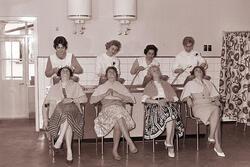The Catwalk Or The Cafeteria?
Imagine it’s the first week of September. In New York City that means two things: school is starting, and midtown Manhattan is filling up with fashionistas and papparazzi; it’s Fashion Week. Like every other high school student in the city, I take the subway to school and back. But every September, my ride is much different than usual. It’s the same six stops with the same black backpack and denim jacket, but suddenly there’s a six-foot tall model hovering over my shoulder. New York Fashion Week has a funny way of marching (in stilettos) right into my otherwise “denim and down jacket” daily life.
This annual glamour parade, which typically coincides with Rosh haShanah (the Jewish New Year), always raises the question of what it really means to dress like a New York City schoolgirl. The private school scene in New York is very closely connected to the Jewish day school scene. The truth is, in both private school and day school, where rates of affluence are high, there is increased pressure to look cool and fashion forward, and to dress like everyone else. Of course, for as long as there have been teenage girls, there have been teenage fashion parades. Unfortunately, it’s an essential characteristic of high school and, in particular, of private school. But shouldn’t Jewish kids at Jewish schools connect to Jewish values? Shouldn’t we be striving for what’s meaningful, lasting, and important? Can’t we transcend the superficial and everything that is only skin deep?
What, if anything, do I and my fellow Jewish day school students have in common with the Fashion Week models? They’re super tall and very skinny, with angled features and stick-straight hair. It’s no coincidence that straight hair is associated with power, and so many of my peers regularly look as though they have spent hours straightening theirs. And when I choose to partake in that teenage ritual, the compliments from my friends flow. As the mild aroma of burning curls fills the room and brings the bathroom mirror to a fog, it’s clear that I too have succumbed to the competitive nature of the 21st century city teen. But it doesn’t take very long for me to miss my stereotypical Jewish-girl curls, and all that they represent in my life. These ethnic curls are crushed, not only by the heat of the iron, but also by the pressure brought on by the Fashion Week models, pressure that causes girls to “iron out” their Jewish appearance.
I have to admit that for better and for worse, I have always enjoyed the freedom to dress however my heart desires; for example, I’ve been privileged enough to have avoided the limitations of a dress code. However, in a recent casual conversation with a friend I found myself saying, “wouldn’t it all be easier if every girl wore identical outfits?” As a girl who’s a little into fashion but a lot into feminism, I was pretty shocked to hear this coming out of my own mouth. School uniforms: why would I ever suggest restricting girls’ self-expression? My friend reminded me that unfortunately, the way girls are encouraged to dress is not so much a reflection of their individuality, but instead reflects the price they are willing to pay to look like everyone else. In other words, what’s the difference between dressing in the latest trends and dressing in an overpriced uniform?
Nothing would make me happier than seeing fashion, feminism, and Jewish girls coexist. But unfortunately I’ve seen that when one pairs 16-year-old private school girls with Prada, it’s a bloodbath. This obsession with labels and looks is completely superficial, and creates an environment that is competitive for all the wrong reasons. The social environment in our private schools is not one that fosters the empowerment of teenage girls. An empowered teenage girl is not one whose status is declared by the designer label on her backpack. An empowered teenage girl is not raised in an environment where a flat iron, a fake smile, and a pile of price tags can mask Jewish identity. An empowered teenage girl breaks away from the restricting classist norms of the New York City Jewish Day School social circuit.
As a feminist, I aspire to be a thoughtful, intellectual, strong woman—not a privileged clone. Feminism has enabled girls and women to run for President of the United States and to sit on the Supreme Court (go RBG!). Finally, the press seems to have moved away from commenting on Hillary Clinton’s pantsuits, and toward focusing more on her intellect and eligibility to run alongside her male competitors. The emphasis on fashion, looks, and competition based on appearance is so yesterday—so let’s get rid of it!
This piece was written as part of JWA’s Rising Voices Fellowship.







